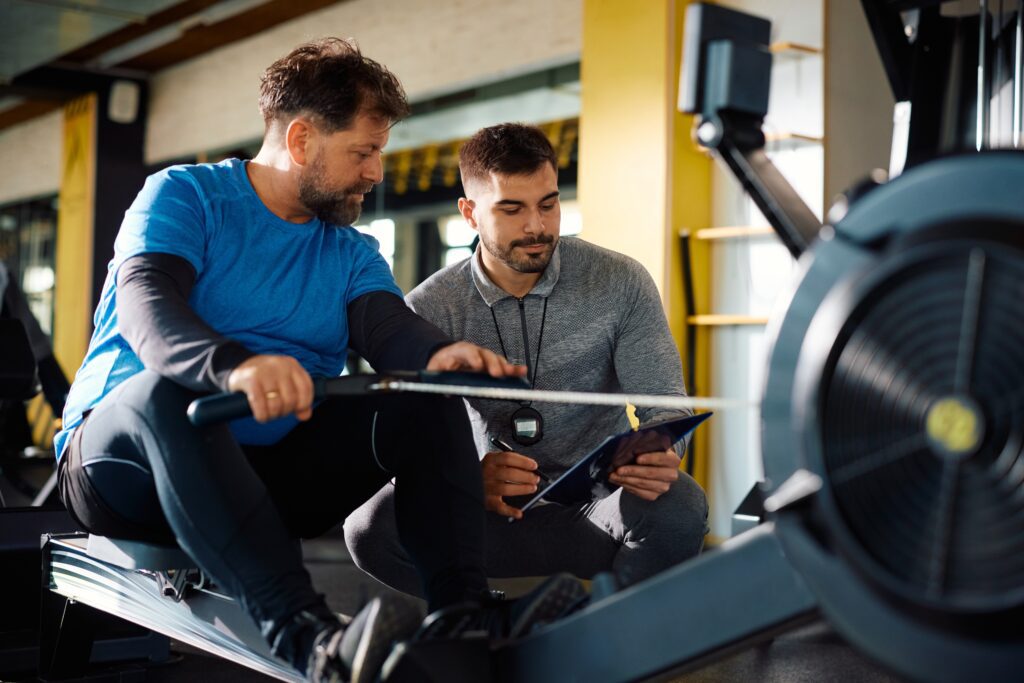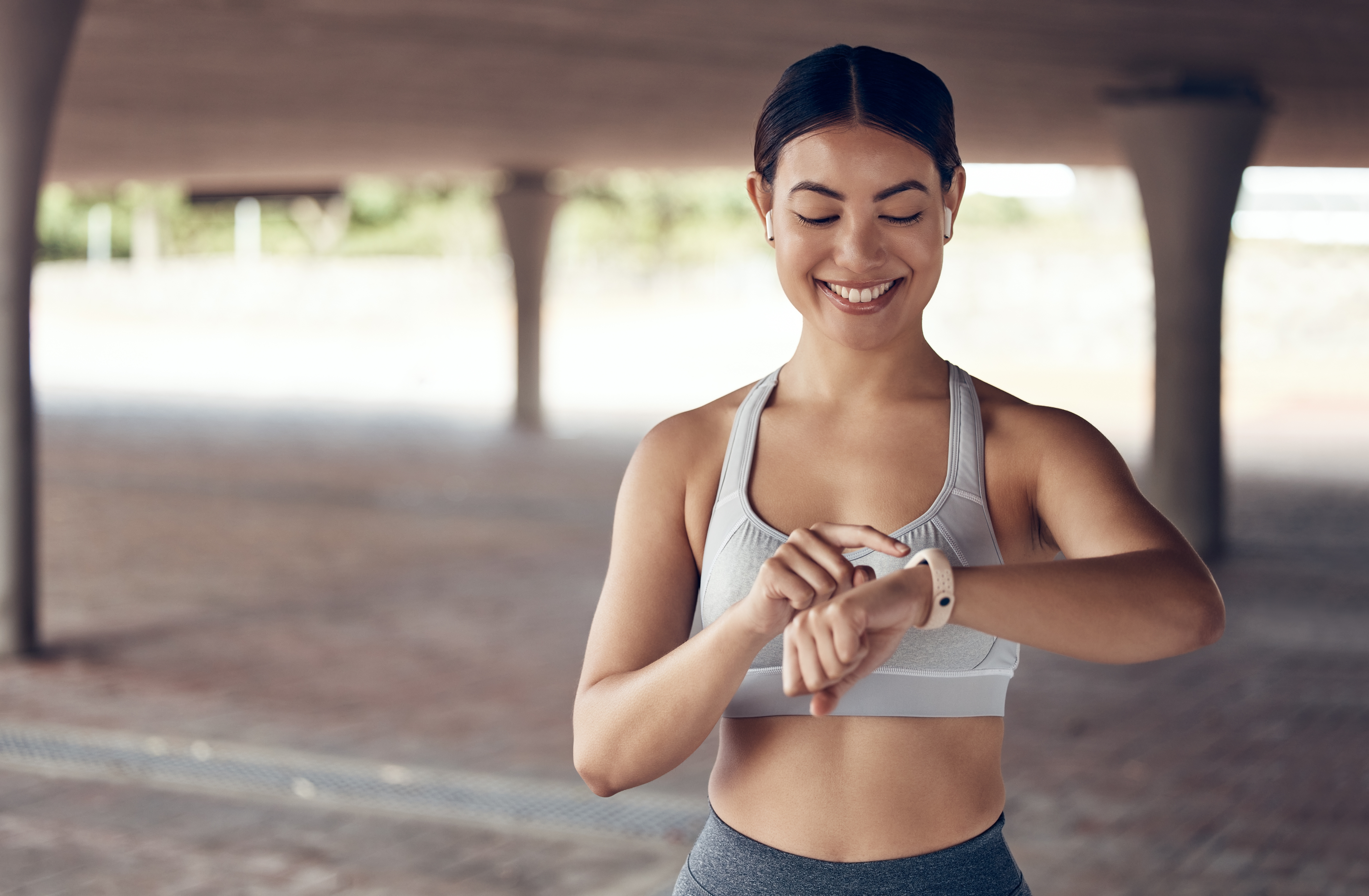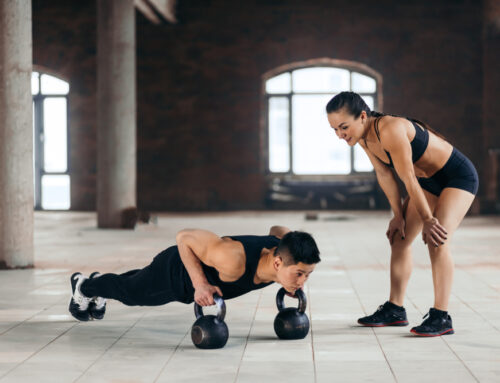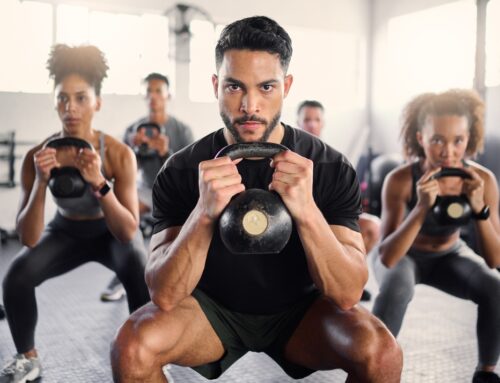AI, or artificial intelligence, is a hot topic and has already made headway into the world of health and fitness. Some people may feel uneasy about the use of AI for fitness as they fear it may take away clients from their gyms, weaken community bonds at gyms, and maybe steer people away from a gym if they can work out from home. While there are a variety of reasons that lead people to join or not join a gym, AI can be a great tool for those who are currently active at a local gym to help them reach their goals more directly.
You may be surprised at the different ways you can use AI to improve fitness for you or your clients. Artificial intelligence like Chat GPT or Google Gemini can be excellent tools to spice up your workouts. We have you covered with some ways you can let AI work for you in the world of health and fitness.
What is AI and Why You Should Try It
Artificial intelligence is a computer-like system that can generate a variety of information. AI is used on your smartphone, like Siri, and many security platforms. Essentially, AI is a language model of sorts where you ask, or type, something into the system and it will spit out an answer, resulting from processing endless information on the internet.
The merging of AI and fitness is a newer trend with the rollout of AI fitness apps like Fitbod, Zing AI, and Evolve AI. However, AI is not limited to a smartphone app for the sake of fitness tips and tricks, but fitness tips can also be found in AI systems like Chat GPT or Google Gemini.
But, where do you begin if you’re wanting to use artificial intelligence to your advantage to better reach your fitness and health goals? It can be hard to know, as there are so many different types of AI systems available, and many ways to use AI to meet your needs.
AI can quickly become another tool for you to use for better health and physical strength as it can provide some helpful ways to improve your already set, or barely there, workout routine. It may also be an excellent resource for the person who does not have access to a personal trainer or live close to a gym that has proper gym equipment.
Ways to Use AI to Improve Your Fitness
The main idea of using AI to improve your fitness is to make it work for you by getting creative with what you need from it! First, take a look at what some of your goals are regarding your current health and fitness. Maybe you need to dial in on the nutritional aspect of your health or need to amp up how often you visit your local gym. AI can assist by generating ideas or plans for you to go further in your fitness and health goals.
AI for Training Schedules
One simple way to use AI as a resource for you is by prompting it to create a training schedule for you. If you’re someone who needs to see a visual idea of what a set workout schedule can look like for you, ask AI! Before you ask an AI system like Chat GPT to write out a training schedule for you, you need to know your specifics first. Consider what your goals are, your current fitness level, how often you want to work out weekly, and for how long. You’ll want to be extremely specific, down to including the equipment you do or don’t have, and the movements you do or do not want to include. Having these talking points in your AI prompt will help it create a more specialized training plan for you.
Here is an example of an AI prompt when needing a training, or workout, schedule:
“Write out a workout schedule for me that focuses on upper and body muscle groups, 2 times a week, for 60 minutes, with 20-pound dumbbells available, without planks.”
Here is an example of one of the many different types of AI training schedules you may receive:
Day 1: Full Body Strength Workout (Upper & Lower)
Warm-Up (5-10 minutes)
- Arm Circles (1 minute)
- Bodyweight Squats (2 sets of 10)
- Dynamic Chest & Shoulder Stretching (arm swings, shoulder rolls)
Workout (50-55 minutes)
- Goblet Squat: (using one dumbbell) 4 sets x 12-15 reps
- Dumbbell Bench Press: (or Floor Press) 4 sets x 10-12 reps
- Dumbbell Romanian Deadlift: 4 sets x 12 reps
- Dumbbell Shoulder Press: 3 sets x 10-12 reps
- Dumbbell Row: (Bent-Over or Single Arm) 4 sets x 12 reps per arm
- Dumbbell Triceps Kickback: 3 sets x 12 reps per arm
- Plank to Dumbbell Row: (Renegade Rows)3 sets x 10 reps per side
Cool-Down (5-10 minutes)
- Chest Stretch (Doorway stretch or hands behind back)
- Hamstring Stretch (Seated or standing)
- Child’s Pose (for lower back and hips)
Day 2: Full Body Strength Workout (Upper & Lower)
Warm-Up (5-10 minutes)
- Dynamic Leg Swings (front-to-back, side-to-side)
- Shoulder Rolls (1 minute)
- Glute Bridges (2 sets of 10)
Workout (50-55 minutes)
- Dumbbell Deadlift: (conventional or sumo) 4 sets x 12 reps
- Dumbbell Chest Press: (Flat or Incline, if available) 4 sets x 10-12 reps
- Dumbbell Squat to Press (Thrusters): 3 sets x 12 reps
- Dumbbell Bent-Over Rows: 4 sets x 12 reps
- Dumbbell Bicep Curl: 4 sets x 12 reps
- Dumbbell Bulgarian Split Squat: (no lunges, but split squat works similarly) 3 sets x 10 reps per leg
- Russian Twists: (using one dumbbell) 3 sets x 20 reps (10 per side)
Cool-Down (5-10 minutes)
- Glute Stretch
- Lower Back Stretch (Child’s Pose or seated forward fold)
- Chest Stretch (hands behind back)
AI for Customized Meal Plans
A consistent workout routine goes hand in hand with a dedicated meal plan. Meal planning, or prepping, can be overwhelming as there is so much information out there about this topic. Plus, different people are focused on different parts of their nutrition such as macros, calories, etc. Instead of spending hours scrolling through different pages, blogs, or videos offering advice on how to plan, using AI in this sense can cut that time in half.
Similar to how you ask AI to generate a training schedule for you with specifics, you’ll want to do the same when asking AI to create a meal plan for you. For example, in your prompt, you’ll want to include which types of food you want to focus more on, such as protein, and less on, such as sugar.
Here is one type of prompt you can give AI to generate a customized meal plan for you to better reach your health and fitness goals:
“Write me a 3-day meal plan (breakfast, lunch, and dinner) focused on protein, gluten-free, without added sugar or processed foods, to help with muscle gain.”
Here is one of the meal plans AI can provide based on a prompt like this:
Day 1
Breakfast: Egg & Veggie Scramble with Avocado
- 3 eggs scrambled with spinach, bell peppers, and onions, cooked in olive oil.
- 1/2 avocado sliced on top for healthy fats.
- Serve with a side of gluten-free toast (if desired).
Lunch: Grilled Chicken Salad with Quinoa
- 6 oz grilled chicken breast, mixed greens (spinach, arugula, kale), cucumber, tomato, and red onion.
- Topped with a handful of cooked quinoa (about 1/2 cup) for carbs and additional protein.
- Dressing: Olive oil, lemon juice, salt, and pepper.
Dinner: Salmon with Roasted Vegetables
- 6 oz grilled or baked salmon (rich in protein and omega-3 fatty acids).
- Roasted vegetables (carrots, zucchini, broccoli) tossed in olive oil and garlic.
- Serve with a side of cauliflower rice or roasted sweet potato.
Day 2
Breakfast: Greek Yogurt with Chia Seeds & Almonds
- 1 cup plain Greek yogurt (high-protein).
- 1 tbsp chia seeds for added omega-3s and fiber.
- A handful of almonds for healthy fats and protein.
Lunch: Turkey Lettuce Wraps with Hummus
- 4 oz turkey breast slices wrapped in large lettuce leaves (romaine or butter lettuce).
- Spread with homemade or store-bought hummus (check for no added sugar).
- Serve with sliced cucumber and a handful of cherry tomatoes on the side.
Dinner: Beef Stir-fry with Vegetables
- 6 oz lean beef strips stir-fried with broccoli, bell peppers, and snap peas.
- Cooked in coconut oil with fresh garlic and ginger for flavor.
- Serve over a bed of cauliflower rice or brown rice (if desired).
Day 3
Breakfast: Protein-Packed Smoothie
- 1 scoop of gluten-free, no-sugar-added protein powder (whey or plant-based).
- 1/2 banana (for natural carbs).
- 1 tbsp almond butter.
- A handful of spinach.
- Unsweetened almond milk or water to blend.
Lunch: Tuna Salad with Avocado
- 1 can of tuna in water (drained), mixed with 1/2 avocado, diced celery, and red onion.
- Seasoned with olive oil, lemon juice, and mustard (without added sugar).
- Serve with a side of mixed greens or gluten-free crackers.
Dinner: Chicken Thighs with Roasted Brussels Sprouts & Sweet Potato
- 6 oz skinless chicken thighs, roasted or grilled with olive oil and herbs.
- Roasted Brussels sprouts tossed in olive oil and garlic.
- Baked sweet potato (about 1 medium) for slow-digesting carbs.
Again, when asking AI to generate a meal plan for you for your fitness goals, get specific including amounts of food, ingredients, and allergies if warranted. Meal plans are unique to everyone, and AI can seamlessly create a personalized meal plan when prompted accordingly.
AI for Creating Better Workouts
Now that you have an idea of what creating a meal plan and workout routine with AI can look like, let’s see how you can amp up your already set workout with AI! It’s normal to get stuck in a workout routine that feels monotonous, and no one wants a boring workout. You can spice it up, while still focusing on your desired muscle groups with the help of AI.
Here is one AI prompt for when you want to create a better and somewhat different workout than usual.
“Write out an upper body workout routine, 45 minutes long, that focuses on biceps, triceps, back muscles, and some core. Tell me unique, and fun movements that include a 20-pound dumbbell.”
With an AI prompt like this, you may find it generates a result such as:
Warm-up (5 minutes)
- Arm Circles (1 minute)
- Dynamic Chest Stretch (1 minute)
- Torso Twists (1 minute)
Workout Routine (40 minutes)
1. Dumbbell Bicep Curl to Overhead Press (12 reps each side)
- Focus: Biceps, shoulders, and forearms.
Rest: 45 seconds
2. Renegade Rows with Dumbbell (12 reps per side)
- Focus: Core stability, upper back, and arms.
Rest: 45 seconds
3. Dumbbell Skull Crushers on the Floor (12-15 reps)
- Focus: Triceps
Rest: 45 seconds
4. Single-arm Dumbbell Row with Leg Raise (12 reps per side)
- Focus: Back, glutes, and core.
Rest: 45 seconds
5. Dumbbell Bicep Hammer Curl to Squat (12 reps)
- Focus: Biceps, forearms, quads, and core.
Rest: 45 seconds
6. Plank to Push-Up with Dumbbell Pass (12 reps)
- Focus: Core, chest, shoulders, and triceps.
Rest: 45 seconds
7. Dumbbell Sumo Deadlift to Upright Row (12 reps)
- Focus: Back, traps, glutes, and shoulders.
Rest: 45 seconds
8. Dumbbell Core Twist (20 reps)
- Focus: Obliques, abs.
Rest: 30 seconds
Cool Down (5 minutes)
- Seated Forward Fold (1 minute)
- Triceps Stretch (1 minute per arm)
- Torso Rotation Stretch (1 minute)
Final Tips on AI Prompts for Fitness
When asking AI to generate a fitness plan for you, be sure to get very specific with what you want. In the prompt be sure to include details such as:
- The length of your workout and frequency. For example, “Write out a 5-day workout plan that is 45 minutes long, including a warm-up and cool down that are 5 minutes each.”
- Which type of movements you want to include or not include like, “Write out a workout routine that is 45 minutes long, focused on the whole body, but does not include lunges, but does include squats.”
- Including which type of muscle group you want to focus on by writing, “Write out a 60-minute workout focused on the lower body with endurance through the use of a treadmill and a 15 minute weight lift portion focused on the lower body.”
- Let AI know if you do or don’t have equipment in your prompt! You may be surprised to see the many different ways you can still get a full workout even if you don’t have access to dumbbells or gym equipment.
Benefits of AI in Health and Fitness
Beyond AI providing new ideas for workout routines, plans, and meal plans it provides additional benefits in the world of fitness. In some cases, AI can bring benefits to gym and fitness enthusiasts by:
- Providing feedback on your workout session, such as an Apple Watch
- Providing insight into your sleep quality, such as an Oura Ring
- Providing an ideal target strain to reach for the day with Whoop
- Providing tracking on how much water you have consumed throughout the day
There are an array of fitness trackers available that you can use to your advantage based on your goals. Some fitness trackers to consider include:
- Walking tracker which can determine how many steps you have taken during the day
- Nutrition tracker, like a nutrition app, where you can log which foods you have eaten in the day. This can help to track and log how much protein you got in the day, and how much more you need to meet your goals.
These types of AI health and fitness trackers are an excellent resource to use for the person who likes to see their progress over time. Tracking this progress can be helpful to see how far you’ve come, and encourage you to keep reaching towards your goals!
Using these types of trackers can also help you to hone in on a more specific prompt to ask ChatGPT. This can look like plugging in the recovery score from an app like Whoop, and asking ChatGPT for a workout routine that reaches a set amount of strain range. Another example is using the recommendations from an app like MyFitnessPal to meal prep more directly.
What AI Can’t Replace in the Fitness World
For all the benefits that come from AI and its impact on helping many meet their fitness or health goals, there are a few things AI can’t replace in the fitness world. Mainly, artificial intelligence will never be able to replace the gold standard that is working with a personal trainer to better reach your fitness goals. Personal trainers, and even class workouts, offer strong community, accountability, and sincere encouragement that a computer system like AI can’t deliver.
Being in a gym, surrounded by other gym goers who are also working to meet their fitness goals, provides determination to stay focused too! Personal trainers and gym peers bring in the human connection of verbal encouragement and praise for when goals are met, and on the days when it is a struggle to simply show up. Plus, we all love a good gym friend who slides an extra 10lbs on the leg extension machine when we don’t want to go heavier.
AI can’t replace these factors, and it can’t hold you accountable to show up daily or weekly to the gym to become a better version of yourself. You can disappoint AI and feel fine, but disappointing your personal trainer or other gym peers is usually more bothersome.
In addition, AI is unable to correct form when working out, meaning there may be an increased chance of injury. Whereas an in-person gym session with a coach or personal trainer provides a level of safety and a decreased risk of injury as they can help correct improper form.
Despite its intelligence and ability to provide endless amounts of information, AI will never be able to replace the human connection that is found with personal trainers, gym friends, and gym communities in the fitness world.
Meet Your Fitness Goals with Carbon Performance

The bottom line is AI is not going away, and it will impact a variety of sectors of life, but instead of fearing it, gym goers or gym owners can let it work for them. By using it to your advantage, and as a resource, you can reach any fitness goal you may have.
But, when it comes to creating community, bonds, and accountability in the fitness world, it’s best found in local gyms and fitness centers like Carbon Performance.
With locations across the southeast area, you’ll be able to find the right location for you, with a team of skilled personal trainers ready to help you on your fitness journey. We offer a variety of workout classes from Yoga to HIIT. You can also try out your own, personal workout routine with our state-of-the-art gym equipment.
Join in on the mission of Carbon Performance today and transform your fitness and wellness with us.







